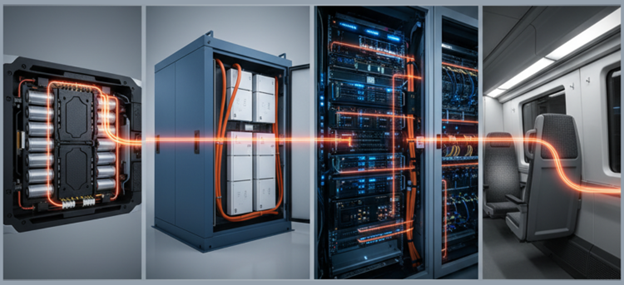
Published
by Rogers Corporation
Elastomeric Material Solutions
UL 94 V-0 is one of the most recognized flammability classifications in engineering, and for good reason. As systems become smaller, more powerful, and more integrated, the risk of ignition from electrical or thermal sources continues to rise.
Today, more industries are turning to V-0 testing to strengthen their safety strategies and meet growing compliance demands. From electric vehicles (EVs) and battery energy storage systems (BESS) to data centers and rail systems, the push for self-extinguishing materials is transforming how engineers approach fire mitigation and material selection.
However, not every component benefits equally from a V-0 specification. Knowing where flammability performance truly impacts safety and where other material properties take precedence helps engineers make balanced decisions that support reliability, cost, and compliance.
Where UL 94 V-0 Really Matters
These are use cases where a UL 94 V-0 rating typically adds clear compliance or risk-reduction value.
- BESS modules and enclosures (in support of UL 9540/9540A programs)
System tests focus on thermal runaway and propagation at multiple integration levels. While UL 94 V-0 is not a substitute for those evaluations, using V-0 internal foams and gaskets helps increase the likelihood that components do not contribute additional fuel during abuse testing and can simplify internal reviews and Authority Having Jurisdiction (AHJ) discussions. - EV packs and electronics modules
Many automotive OEMs and tier suppliers are starting to shift away from horizontal burn references, such as FMVSS 302, toward UL 94 vertical classifications on select components. V-0 performance in pads, gap fillers, and control-module gaskets helps support OEM validation and simplifies global qualification efforts. - Data center hardware
Server OEMs and networking companies often require UL V-0 for materials inside the enclosure. Fan-frame gaskets, baffles, and internal seals benefit from a soft, compressible V-0 foam that also supports acoustic performance. - Rail and other high-consequence environments
Rail specifications such as EN 45545 evaluate broader fire behavior at the system level. Selecting V-0 foams can support documentation packages and hazard analyses, particularly when flame resistance complements smoke and toxicity requirements.
Where UL V-0 is Not the Deciding Factor
These are common design scenarios in which flame rating alone does not improve safety or system performance:
- Cell-to-cell thermal propagation
Once a cell enters thermal runaway, a V-0 foam does not stop energy release by itself. Propagation mitigation depends far more on pack architecture such as thermal barriers, venting paths, compartmentalization, spacing, heat removal, and the behavior of structural enclosures. - Outdoor and harsh-environment seals
For exterior gasketing such as automotive, chargers, and HVAC rooftop units, UV stability, water sealing under pressure, and high-temperature aging can outweigh flame rating in material selection. In many of these locations, silicone or other chemistries may be the appropriate choice if those environmental exposures are extreme. - Very high operating temperatures
If the design sees sustained temperatures above typical urethane limits, temperature capability and seal retention become the primary constraint even if V-0 is met elsewhere in the system. - Composite stacks with adhesives and films
When foams are laminated or bonded, the composite’s overall burn behavior may differ from the base foam. Always consider the full construction.
Beyond the Flame Rating: What Else Engineers Should Consider
When UL V-0 is a requirement, optimize the rest of the stack so the material solves the actual design problem, not just the checkbox.
- Compression behavior and gap-take-up
Softness and high compressibility reduce assembly force and absorb tolerance stack-ups in densely packed enclosures. - Stress relaxation and compression set
Long-term force retention maintains sealing and cushioning performance over the product life. - Acoustics
In servers and power electronics, low-frequency fan noise matters. A V-0 foam with appropriate absorption at relevant frequencies can reduce noise and vibration concerns. - Material compliance in electronics
Siloxane-free and halogen-free materials minimize contamination risk in sensitive electronics and align with IEC 61249-2-21 and ASTM F2466-10 standards.
Engineers looking for a soft, electronics-friendly V-0 foam that combines reliable compression performance, long-term sealing force retention, and halogen- and siloxane-free chemistry can consider solutions such as PORON® 40V0 polyurethane foam as an example of this balanced design approach.
Where UL 94 V-0 Adds Value vs. Where Other Factors Dominate
| Application Area | Role of V-0 | What Engineers Should Prioritize |
|---|---|---|
| BESS modules & enclosures | Essential – Supports UL 9540/9540A readiness by ensuring foams don’t add fuel load | Flammability compliance, compression reliability, halogen-free materials |
| EV packs & control modules | Essential – OEMs increasingly specify UL 94 V-0 instead of FMVSS 302 | Alignment with evolving specs, long-term mechanical stability |
| Data center servers | Essential – Often a gating requirement for fan seals and internal gasketing | Flammability plus acoustic absorption and low compression set |
| Rail interior components | Important – Contributes to meeting EN 45545 fire performance requirements | Flame, smoke, toxicity ratings together |
| Cell-to-cell propagation zones | Limited impact – Flame rating does not prevent thermal runaway spread | Thermal insulation, pack architecture, venting design |
| Exterior gasketing (auto, HVAC, chargers) | Limited impact – Environmental durability is the constraint | UV resistance, water sealing, high-temp capability |
| High-temperature interfaces | Limited impact – Heat stability trumps flame rating | Continuous temperature resistance, stress relaxation |
| Foam + adhesive laminates | Case-specific – Composite performance may differ from base foam | Evaluate laminate as a whole; adhesive selection may matter |
Key Takeaway
In short, treat UL 94 V-0 as one tool in the safety toolkit. It is valuable where ignition risk is real, but secondary where heat, UV, or stress relaxation dictate failure. When you do need a soft, electronics-friendly V-0 foam, PORON 40V0 material provides a balanced option: self-extinguishing performance with reliable compression and long-term sealing.
Request a PORON 40V0 polyurethane foam sample.
Published on Oct 16, 2025
